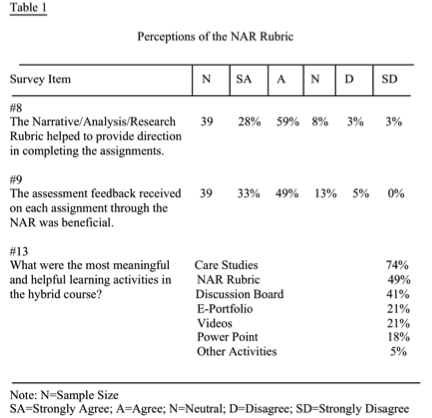| << Chapter < Page | Chapter >> Page > |
The purpose of these questions was to provide insight and answers concerning the effectiveness of the NAR Rubric. The data should provide confirmation of its beneficial utilization and suggestions for future use.
The survey instrument used in this study was developed by the author after discussions with EDAD faculty, students currently enrolled in the EDAD program, and reflection and analysis by the author related to the teaching and learning occurring in the online classes.
This survey consisted of three sections. The first section contained 13 “forced response” questions in which 5 of these questions related directly to the students’ perceptions of the NAR Rubric. The “forced response” questions were set up on a five point Likert Scale ranging from strongly agree – agree – neutral – disagree – strongly disagree. The second section had 2 open-ended questions regarding the students’ views of the course. These open-ended questions were:
The final section was made up of questions asking demographical information on the survey’s respondents.
The survey was sent electronically to the students’ e-mail addresses. Included with the survey was a cover letter explaining the reason for the survey. The participants were assured of the confidentiality of their responses. Survey results were submitted through the Zoomrang program. Through this program, results were compiled and set up according to the questions.
The respondents of the study’s survey were diverse. Of the 39 EDAD students who responded to the survey, 59% were female and 41% were male. Most of these graduate students were teachers at 69% of the total sample population, while 26% were administrators, and 5% were in other job positions. The breakdown of the educational levels for the participants was 51% at the high school level, 8% at the middle school level, and 41% at the elementary level. Finally, the graduate students’ years of experience were quite varied with 18% with 1-3 years of experience, 51% with 4-10 years of experience, 18% with 11-20 years of experience, and 13% with 20 + years experience.
The purpose of the study was to retrieve the student’s perceptions and viewpoints concerning the NAR Rubric and the learning outcomes attributed to the Rubric’s criteria. Some of the questions asked pertained to the NAR Rubric as a beneficial teaching and learning tool and other questions were concentrated on the learning outcomes of the student. To understand the distribution of responses to the survey items, frequency tables were set up to organize and summarize data. Frequency distribution results in Table 1 show the students’ perceptions to survey questions focusing on the NAR Rubric effectiveness.

Table 1 reveals the student’s viewpoints were positive and accepting of the NAR Rubric. The students clearly indicated that the NAR Rubric provided direction in completing online assignments with 87% of the respondents agreeing that the rubric provided this direction.

Notification Switch
Would you like to follow the 'Ncpea handbook of online instruction and programs in education leadership' conversation and receive update notifications?